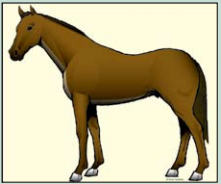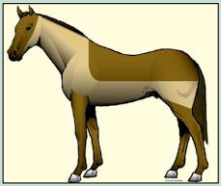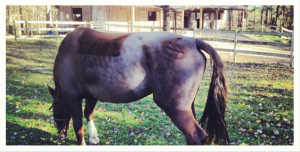As the evenings are dropping in temperature, your horse’s coat is likely changing and growing in thick for the winter. If your horse is in regular work and tends to run hot enough to work up a sweat, you may be considering body clipping. Body clipping allows the horse to dry off quickly after becoming damp or sweaty, reducing the chance of it catching a chill and becoming ill. Not all horses need to be body clipped, and if you only ride your horse leisurely or not at all, he should be fine keeping his coat. There are a variety of types of horse clips to choose from, and depending on the amount of work you will be doing with your horse and how hot he runs, some may be more appropriate than others. Take a look at these popular types of horse clips to see what might work best for you:
- Strip Clip – Remove hair on the underside of the horse’s neck,
 the front of the chest, between his front legs and under his belly. This horse clip is best if your horse is only in light work, as it provides a sort of “vent” to allow a bit of air to cool him while he works. This low-level clip will also allow you to skip using a blanket except in the coldest weather, as the horse will maintain most of his natural, warm coat.
the front of the chest, between his front legs and under his belly. This horse clip is best if your horse is only in light work, as it provides a sort of “vent” to allow a bit of air to cool him while he works. This low-level clip will also allow you to skip using a blanket except in the coldest weather, as the horse will maintain most of his natural, warm coat.
- Trace Clip – Remove hair on the
 underside and lower sides of the horse’s neck, the front and sides of the chest, the lower sides of the horse’s body and his belly. Because this type of horse clip removes hair from the areas where the horse sweats the most, it is commonly seen. Depending on what is best for your horse, you can take a narrow strip of hair along the sides, or go all the way halfway up his body on either side to allow more of an area to be cooled.
underside and lower sides of the horse’s neck, the front and sides of the chest, the lower sides of the horse’s body and his belly. Because this type of horse clip removes hair from the areas where the horse sweats the most, it is commonly seen. Depending on what is best for your horse, you can take a narrow strip of hair along the sides, or go all the way halfway up his body on either side to allow more of an area to be cooled.
 Blanket Clip – Remove all hair on the neck and shoulders and halfway up the sides of his body. Hair left behind should make it appear that the horse is wearing a quarter sheet made of his own hair. Hair on the legs is also left unclipped. Horses in regular, heavy exercise will likely need this type of horse clip.
Blanket Clip – Remove all hair on the neck and shoulders and halfway up the sides of his body. Hair left behind should make it appear that the horse is wearing a quarter sheet made of his own hair. Hair on the legs is also left unclipped. Horses in regular, heavy exercise will likely need this type of horse clip.
- Hunter Clip – Remove all hair except the legs and a saddle pad sized area on the horse’s back. This horse clip is another great option for horses in regular, hard work. Hair is left on the horse’s back to protect from saddle friction and keep the back muscles warmer. A lot of hair is removed with this type of horse clip, therefore you will need to blanket more heavily than if your horse was not clipped.
- Full Clip – Remove all hair on the horse’s entire body, including legs. It is advisable to not clip the horse’s ears in the winter, as the hair protects the thin-skinned ears from frostbite. Many horses that compete through the winter months are given this clip. Blanketing is necessary for a horse that has been fully body clipped.
Consider all the aspects of your horse before deciding on a type of horse clip to use for him. Factor in how much work he will be doing this winter season, how much he normally sweats, and how you’ll be able to blanket him. Once you have the right clippers for the job and you go to clip your horse, tracing an outline of your clip with chalk can be helpful to keep you on the right path as you go. If you are unsure what will be best, start with a lower level clip that removes less hair, then you can easily clip more if you find it is not enough for your horse. And most importantly, ensure you have the correct blankets to keep your horse warm once his natural, warming coat has been clipped either partially or fully off.
What type of horse clip do you find works best? Let us know in the comments!

